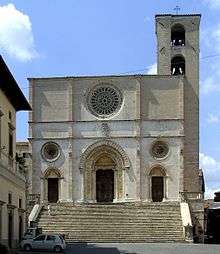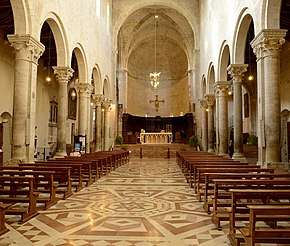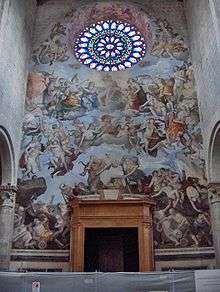Todi Cathedral
Todi Cathedral (Italian: Duomo di Todi; Concattedrale della Santissima Annunziata) is a Roman Catholic cathedral in Todi, Umbria, Italy, dedicated to the Annunciation of the Virgin Mary. It was formerly the seat of the bishops of Todi, and since 1986 has been a co-cathedral of the diocese of Orvieto-Todi.

History
The cathedral stands on the site of a Roman edifice in the former Roman forum, in the present Piazza del Popolo in the centre of the city of Todi. Its early history is obscure. The earlier church here, believed to have been built around the year 1000, was almost completely destroyed by a fire in 1190. The rebuilt cathedral was finished in the 14th century, but the structure has been refurbished and altered several times since then.
Description
Exterior
The cathedral stands above two terraces at the top of a flight of steps.
The west front dates from the 13th century but has been modified several times, most recently in the 16th century.
The central rose window was begun in 1515 and completed under Bishop Biliotti between 1517 and 1523. The stained glass is not original, but is the result of 19th century restoration.
The central portal, in wood, with a pointed arch, has a double door of 1521 by Antonio Bencivenni consisting of four upper panels depicting the Annunciation, the Archangel Gabriel, Saint Peter and Saint Paul, and six lower panels added in 1639.
To the south of the frontage stands the campanile of the 13th century, coeval with the apse.
Interior

The cathedral is built on a Latin cross plan. The nave is subdivided into three aisles, of which the central one is the widest and tallest, separated by two arcades of round arches supported by Corinthian columns. The main nave and side aisles are roofed with wooden beams, whereas the transept has groin vaulting.
At the entrance to the southern aisle is the font, made by Piero di Moricone from Lugano in 1507.
On the counterfaçade is a fresco of 1596 by Ferraù Fenzoni known as "Il Faenzone" depicting the Last Judgment, inspired by Michelangelo's treatment of the same subject in the Sistine Chapel.
The wooden choir stalls are the work of Antonio Bencivenga and his son Sebastiano between 1521 and 1530.
In the apse is a crucifix painted on a panel, dating from the mid-13th century, while to the north of the presbytery is the Cesi Chapel, established by Bishop Angelo Cesi; the vault has frescoes of 1599 by Il Faenzone, who also created the painting on the chapel altar.
In the crypt are three sculptures previously on the west front, attributed to Giovanni Pisano and to "Il Rubeus".
Gallery
 The Gothic portal
The Gothic portal Exterior of the apse
Exterior of the apse The Last Judgment (1594-99) by Ferraù Fenzoni
The Last Judgment (1594-99) by Ferraù Fenzoni The high altar and the Crucifixion (13th century)
The high altar and the Crucifixion (13th century)
Bibliography
- Prandi, Adriano, 1980: Ombrie romane, pp. 269-283. Zodiaque, Abbaye Sainte-Marie de la Pierre-Qui-Vire, Saint-Léger-Vauban
- Santini, Loretta, 1987: L'Ombrie, nouveau guide, p. 59. Éditions Plurigraf, Narni - Terni
- Touring Club Italiano, 2004: L'Italia: Umbria. Touring Club Italiano-La Biblioteca di Repubblica
External links
- Todi.org - La Cattedrale di Todi (in Italian)
- Medioevo.org - Il Duomo di Todi (in Italian)
- L'organo (in Italian)
| Wikimedia Commons has media related to Todi Cathedral. |